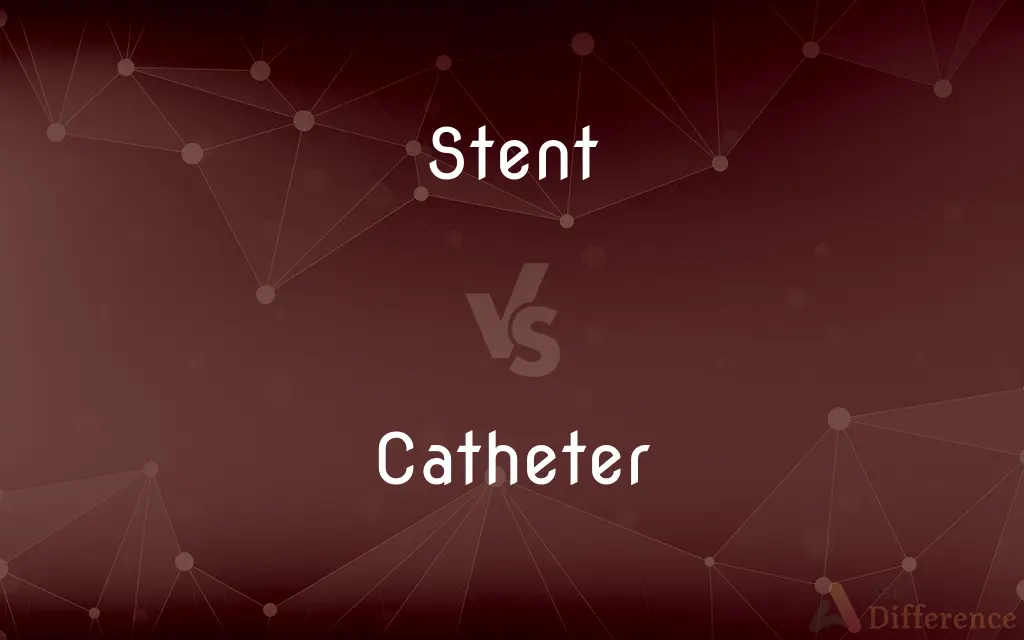Stent vs. Catheter — What's the Difference?
By Tayyaba Rehman & Urooj Arif — Updated on March 28, 2024
Stents are devices permanently placed to keep passageways open, while catheters are temporary tubes for fluid administration or removal, serving different medical purposes.

Difference Between Stent and Catheter
Table of Contents
ADVERTISEMENT
Key Differences
A stent is a small, often metal or plastic, tube that is permanently inserted into a vessel or duct to keep it open, enhancing or enabling the flow of bodily fluids. On the other hand, a catheter is a flexible tube temporarily placed in the body to remove fluids, administer drugs, or perform diagnostic procedures.
While stents are primarily used to open narrowed or blocked passageways, such as arteries, to prevent or treat conditions like coronary artery disease, catheters are utilized for a broad range of functions including draining urine from the bladder (urinary catheters), administering intravenous therapies (IV catheters), and performing diagnostic tests in cardiology (cardiac catheters).
Stents are left in place for extended periods, often permanently, to provide continuous support to vessels or ducts. Catheters, however, are designed for temporary use, with their duration of stay ranging from a few minutes during certain procedures to several weeks in cases like urinary catheterization.
The placement of a stent is typically a more invasive procedure that may require surgery or minimally invasive techniques such as angioplasty. In contrast, catheter insertion is generally less invasive, with many types of catheters being placed without the need for surgery.
The choice between a stent and a catheter depends on the medical condition being treated. Stents are the go-to for long-term opening of passageways, whereas catheters are chosen for temporary access to the body's internal environment for a variety of medical purposes.
ADVERTISEMENT
Comparison Chart
Purpose
To permanently open narrowed or blocked passageways.
To temporarily remove or administer fluids, or perform diagnostics.
Material
Often made of metal or special plastics.
Made of flexible materials like silicone or latex.
Duration of Use
Usually permanent or long-term.
Temporary, ranging from minutes to weeks.
Procedure Type
More invasive, may require surgery or angioplasty.
Generally less invasive, often not requiring surgery.
Primary Use
Opening arteries, bile ducts, etc.
Draining urine, administering drugs/IV fluids, diagnostic tests.
Compare with Definitions
Stent
Device to keep passageways open.
A coronary stent was placed to prevent artery closure.
Catheter
Temporary use.
Catheters are used during surgery for temporary fluid management.
Stent
Often metal or plastic.
A metal stent is commonly used in heart surgeries.
Catheter
Various types for different uses.
IV catheters are used for medication delivery.
Stent
Permanent solution.
Stents are designed to remain in the body indefinitely.
Catheter
Tube for fluid administration/removal.
A urinary catheter drains the bladder.
Stent
Requires precise placement.
Proper stent placement is crucial for its effectiveness.
Catheter
Flexible material.
Catheters are made from materials like silicone for comfort.
Stent
Used in various body parts.
Stents can be placed in arteries, ureters, or bile ducts.
Catheter
Less invasive insertion.
Catheter placement is generally a simple procedure.
Stent
In medicine, a stent is a metal or plastic tube inserted into the lumen of an anatomic vessel or duct to keep the passageway open, and stenting is the placement of a stent. There is a wide variety of stents used for different purposes, from expandable coronary, vascular and biliary stents, to simple plastic stents used to allow the flow of urine between kidney and bladder.
Catheter
In medicine, a catheter is a thin tube made from medical grade materials serving a broad range of functions. Catheters are medical devices that can be inserted in the body to treat diseases or perform a surgical procedure.
Stent
A substance used in dentistry for taking impressions of the teeth.
Catheter
(medicine) A small tube inserted into a body cavity to administer a drug, create an opening, distend a passageway, or remove fluid.
Stent
An assessment of property made for purposes of taxation
It was recorded in the stent book
Catheter
The name of various instruments for passing along mucous canals, esp. applied to a tubular instrument to be introduced into the bladder through the urethra to draw off the urine.
Stent
Assess and charge (a person or a community) for purposes of taxation
Stent the Parish of Kildaltan in the ascertained sum
Catheter
A thin flexible tube inserted into the body to permit introduction or withdrawal of fluids or to keep the passageway open
Stent
A device used to support a bodily orifice or cavity during skin grafting or to immobilize a skin graft following placement.
Stent
A short tubular device made of wire mesh or fabric that is placed permanently in an anatomical passage, usually an artery during angioplasty, to keep it open after occlusion.
Stent
(archaic) An allotted portion; a stint.
Stent
(archaic) To keep within limits; to restrain; to cause to stop, or cease; to stint.
Stent
(archaic) To stint; to stop; to cease.
Stent
To keep within limits; to restrain; to cause to stop, or cease; to stint.
Then would he weep, he might not be stent.
Yet n'ould she stentHer bitter railing and foul revilement.
Stent
To stint; to stop; to cease.
And of this cry they would never stenten.
Stent
An allotted portion; a stint.
Common Curiosities
Can a catheter be used long-term?
Some catheters, like certain urinary catheters, can be used for extended periods but are still considered temporary.
What is a stent?
A stent is a device inserted into a passageway to keep it open.
How do healthcare providers decide between a stent and a catheter?
The decision is based on the medical condition, goals of treatment, and the patient's overall health.
What is a catheter?
A catheter is a flexible tube for removing or administering fluids, or performing diagnostics.
Are stents always made of metal?
Not always; stents can also be made from special plastics or other materials suitable for permanent implantation.
How is a catheter inserted?
Catheter insertion varies by type but generally involves a less invasive procedure than stent placement.
How are stents and catheters different in purpose?
Stents provide a permanent solution to keep passageways open, whereas catheters offer temporary access for medical interventions.
What are common uses for catheters?
Draining urine, administering IV fluids or medications, and aiding in diagnostic procedures like cardiac catheterization.
What conditions require a stent?
Conditions like coronary artery disease, peripheral artery disease, and certain types of blockages in the urinary tract or bile ducts.
Is stent placement painful?
The procedure can be uncomfortable, but it is usually performed under anesthesia to minimize pain.
Can stents be removed?
Most stents are designed to be permanent, but some types can be removed if necessary.
What risks are associated with catheters?
Risks include infection, irritation, and in rare cases, injury to the area being accessed.
Do all stents prevent heart attacks?
While stents can reduce the risk by keeping arteries open, they do not eliminate the possibility of heart attacks.
Can anyone have a stent or catheter?
Eligibility depends on specific medical conditions and factors, assessed by healthcare providers.
How do patients manage with long-term catheters?
Proper care and hygiene practices are essential to prevent infections and ensure comfort.
Share Your Discovery

Previous Comparison
Anticlockwise vs. Clockwise
Next Comparison
Authoritarian vs. AutocraticAuthor Spotlight
Written by
Tayyaba RehmanTayyaba Rehman is a distinguished writer, currently serving as a primary contributor to askdifference.com. As a researcher in semantics and etymology, Tayyaba's passion for the complexity of languages and their distinctions has found a perfect home on the platform. Tayyaba delves into the intricacies of language, distinguishing between commonly confused words and phrases, thereby providing clarity for readers worldwide.
Co-written by
Urooj ArifUrooj is a skilled content writer at Ask Difference, known for her exceptional ability to simplify complex topics into engaging and informative content. With a passion for research and a flair for clear, concise writing, she consistently delivers articles that resonate with our diverse audience.














































